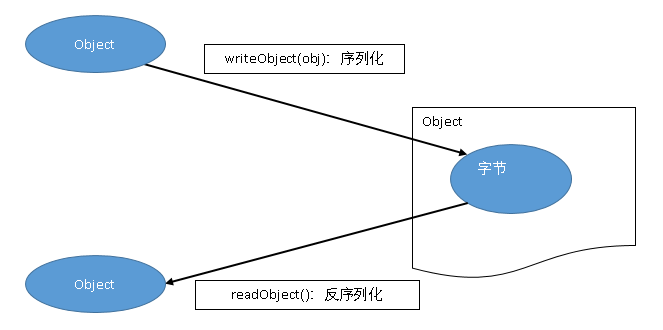序列化
序列化:Serialize,将Java对象写入IO流(可以保存在数据库,文件等)
反序列化:Deserialize,从IO流中读取并恢复Java对象。
这么理解:序列化就是把对象封印起来,反序列化就是解封。
对象中包含的不仅仅是字符,更多的是非字符,因此需要使用字节流。
所有能在网上传输的对象的类都应该是可序列化的,否则程序就会出现异常。

实现Serializable接口
这个接口里面什么都没有,是一个标记接口,表明一个对象是可以序列化的。
public interface Serializable {
}
transient:瞬态关键字
|--transient变量---不参与序列化(有些变量可能属于敏感信息,如银行账户密码等)
transient:短暂的。
import java.io.*;
public class 序列化1 {
public static void main(String[] args) throws Exception {
int r_w = 3;
if (r_w == 1) {
on序列化();
} else if (r_w == 2) {
on反序列化();
} else {
on序列化();
on反序列化();
}
}
private static void on序列化() throws Exception {
Dog _d = new Dog("狗", "金毛");
File f = new File("myObj.txt");
System.out.println("序列化:" + f.getAbsolutePath());
FileOutputStream fos = new FileOutputStream(f);
ObjectOutputStream oos = new ObjectOutputStream(fos);
oos.writeObject(_d);
oos.close();
fos.close();
}
private static void on反序列化() throws Exception {
// 前提:1.类必须可序列化,2.必须有对应的类文件
File f = new File("myObj.txt");
FileInputStream fis = new FileInputStream(f);
ObjectInputStream ois = new ObjectInputStream(fis);
Dog d = (Dog) ois.readObject();
System.out.println("反序列化:" + d + ": name = " + d.name);
ois.close();
fis.close();
}
}
class Dog implements Serializable {
private static final long serialVersionUID = 1L;
public Dog(String name, String type) {
super();
this.name = name;
this.type = type;
}
String name;
transient String type;
@Override
public String toString() {
System.out.println("type:没参与序列化");
return "【狗狗:name = " + name + ", type = " + type + "】";
}
}
运行结果:
序列化:C:UsersAdministratorgitAh01JspJavaHtmlmyObj.txt
type:没参与序列化
反序列化:【狗狗:name = 狗, type = null】: name = 狗
序列号: serialVersionUID
|--修改类的定义,可能生成新的序列号
|--|--改构造器:变
|--|--改字段:变(包括transient字段)
|--|--改方法体里的实现,不变;
序列化和反序列化时的序列号如果不同,会抛出异常java.io.InvalidClassException
可以显示声明一个固定的序列号。如:
private static final long serialVersionUID = 1L;
*另一种序列化方法:实现Externalizable接口
Externalizable接口可以替代Serializable接口。
需要手提供一个无参构造方法,否则在反序列化的时候会抛出异常
java.io.InvalidClassException: ……; no valid constructor
同时还需要定义两个方法(writeExternal()和readExternal())来控制要序列化的字段。
下列示例,只有Dog类的实现和上例不一样,其余代码可以一样。
package ah.externalizable;
import java.io.*;
public class 序列化2 {
public static void main(String[] args) throws Exception {
on序列化();
on反序列化();
}
private static void on序列化() throws Exception {
Dog _d = new Dog("狗", "金毛");
File f = new File("myObj.txt");
System.out.println(f.getAbsolutePath());
FileOutputStream fos = new FileOutputStream(f);
ObjectOutputStream oos = new ObjectOutputStream(fos);
oos.writeObject(_d);
oos.close();
fos.close();
}
private static void on反序列化() throws Exception {
File f = new File("myObj.txt");
FileInputStream fis = new FileInputStream(f);
ObjectInputStream ois = new ObjectInputStream(fis);
Dog d = (Dog) ois.readObject();
System.out.println(d + ": name = " + d.name);
ois.close();
fis.close();
}
}
class Dog implements Externalizable {
public Dog() {
// 不写空构造,读不出来(可以写)
}
public Dog(String name, String type) {
super();
this.name = name;
this.type = type;
}
String name;
String type;
@Override
public void writeExternal(ObjectOutput out) throws IOException {
// 不写的Field就不序列化
out.writeUTF(name);
out.writeUTF(type);
}
@Override
public void readExternal(ObjectInput in) throws IOException, ClassNotFoundException {
// 读取顺序务必和写入顺序相同
name = in.readUTF();
type = in.readUTF();
}
@Override
public String toString() {
return "【狗狗:" + name + ", 是一只" + type + "】";
}
}